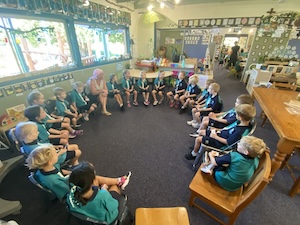Communicating within the Pacific Way
Communicating within the Pacific Way
The beauty of split assemblies allows us to cater our messages to a specific audience. At this week's Prep – Year 2 assembly, Mrs Ridley and Mrs Hogan explored the concept of what communication means to us in the different situations that we find ourselves in.
A favourite of little people, that we are all familiar with is Bluey. In the episode that was shown, Bingo, Bluey’s little sister, does not speak up when her dad, however well-meaning, plays a little rough with her. She is encouraged to use her “big bark” to let others know that how they are treating her, is not ok. As a result, in assembly, the children were encouraged to do the same when faced with a similar situation.
The key messages were
- People are in charge of their own bodies.
- Sometimes things that are fun for you, but not the other person and
- Listening to each other is how we make sure we, and others are safe.
Our “big bark” at school might look like
- That does not make me feel safe or
- When you_______ I feel_______. Please stop.
Encouraging young people to take action and problem solve issues is a crucial part of supporting the whole person. Not only does this benefit others and make interactions more inclusive, it empowers our young people to believe in themselves and build resilience for the future.
Restorative Approaches
Of course, from time to time, our interactions can lead to harm. Both intentional and accidental. Actions of others can impact the wellbeing of all. At Pacific, we use these events as learning experiences and give voice to all sides to encourage a holistic view of what has transpired. A crucial part of the Pastoral Care process at Pacific is the attention and faith given to supporting students through restorative frameworks. It is the purpose of restorative practice to build or mend relationships that are worthy of maintaining. Restorative circles can take many forms and serve many purposes. Restorative conferencing can be a process that addresses wrongdoing and conflict and can seek to repair damage to relationships.
The implementation of Circle Time is an important part of our framework. Circle Time is a practical way to skill young people to listen with understanding, tune into feelings and begin to see the world from others’ viewpoints. These Circle Times are intentionally timetabled into classes to build and maintain relationships and encourage a sense of belonging. The ‘grab and go’ Circle Time kit covers such topics as dealing with arguments, what we need when we are hurt, and blaming versus fixing. The skills built within this environment aim to build our students' capacity further to navigate the sometimes confusing world of interpersonal relationships.
As a College, we encourage our students to be vocal about such incidents whilst at school. Circle Times and restorative conferencing provide an avenue for children to articulate any potential issues that may have occurred. Our hope as a College is that we are encouraging agency within our students to speak up in a safe and supportive environment and undertake the due process to restore the relationships that may have suffered harm. These restorative processes can be the beginning of a journey to repair harm, and at times, require continuous monitoring. Communication is vital, and I encourage you to keep in close contact with your child’s classroom teacher should you need to give further information or need clarification on pastoral matters.
Take care and God bless.
Mr Damian Davis, Head of Staff and Students P-5



